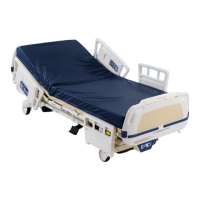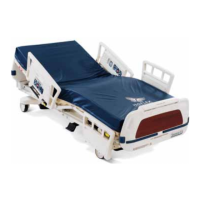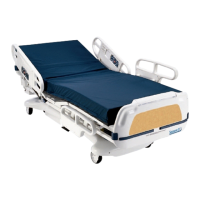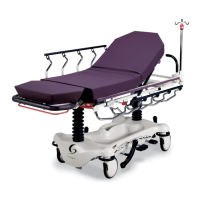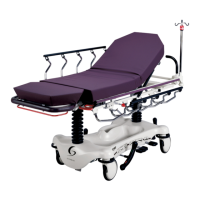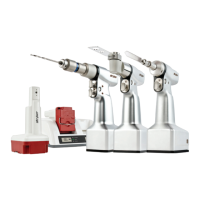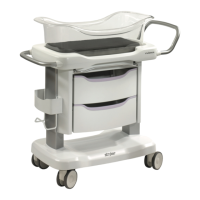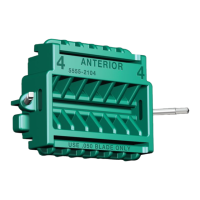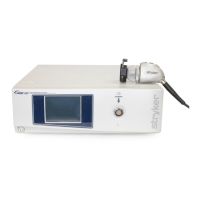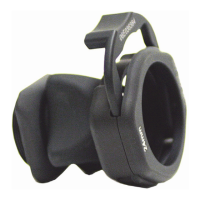1-10 280C-009-002 REV B www.stryker.com
Return To Table of Contents
English
Before operating the GoBed
®
II MedSurg Bed, Model FL28C, it is important to read and understand all information in this
manual. Carefully read and strictly follow the safety guidelines listed below. It is important that all users have been trained
and educated on the inherent hazards associated with the usage of electric beds.
WARNING
• Always unplug the bed power cord from the power source before moving the bed.
• This bed is not intended for pediatric use, i.e., for any patient measuring 35 inches (88,9 cm) or less.
• The maximum load capacity of the monitor tray is 40 lb (18 kg).
• The weight of the I.V. bags must not exceed 11 lb (5 kg) per hook.
• The weight of the I.V. bags must not exceed 40 lb (18 kg).
• The maximum load capacity of the oxygen bottle holder is 75 lb (34 kg).
• The maximum load capacity of the overhead trapeze is 150 lb (68 kg).
• The overhead trapeze is designed to help the patient change position in bed. The trapeze must not be used as a
support to enter or exit the bed. Injuries may result due to improper use of the overhead trapeze. Medical advice
may be necessary to determine if the use of an overhead trapeze is adequate for the patient’s condition or treatment
given.
• To prevent injury to the patient, ensure the trapeze is properly attached to the upper section.
• The overhead trapeze should not be used when in the storage position. This may result in injury to the patient or
damage to the equipment.
• This bed is equipped with a hospital grade plug for protection against shock hazard. It must be plugged directly into
a properly grounded receptacle. Grounding reliability can be achieved only when a hospital grade receptacle is used.
• Shock Hazard - Improper handling of the power cord may result in damage to the power cord and potential shock
hazards. If damage has occurred to the power cord, immediately remove the bed from service, and contact the
appropriate maintenance personnel. Failure to do so could result in serious injury or death.
• Use only hospital grade electric equipment consuming 5A or less with the auxiliary power outlet (optional). The use
of standard electric equipment may bring the current leakage to an unacceptable level for hospital equipment.
• Serious injury can result if caution is not used when operating the bed. Operate the bed only when all people and
equipment are clear of the electrical and mechanical systems.
• Before using the emergency crank during a power failure, always unplug the unit. An unexpected return of power
could rotate the handle and cause injury.
• Ensure all the connectors stay plugged into the electronic board if it is present on the head casing cover.
• Always apply the brakes when a patient is on the bed (except during transport) or when entering/exiting the bed.
Serious injury could result if the bed moves while a patient is getting on or off the bed. After the brake pedal is
engaged, push on the bed to ensure the brakes are applied.
• To help reduce the number and severity of a potential fall when the patient is unattended, keep the siderails in the
fully raised position and the sleep surface horizontal in its lowest position, unless its medical condition dictates
otherwise. When raising the siderails, be sure that you hear the “click” that signals the locked condition. Pull firmly
on the siderail to ensure it is locked into position.
• When the sleep surface sections are articulated, ensure that all the patient’s limbs are within the raised siderails to
avoid patient injury.
• When a patient’s condition requires greater safety measures for his/her security, use the lockout controls in the foot
board control panel to inhibit the siderail functions or remove any optional pendant control and install protective pads
on the siderails.
• Improperly adjusted restraint straps can cause serious injury to a patient. It is the responsibility of the attending
medical personnel to determine proper use of the restraint straps.
• Siderails, with or without their padded covers, are not intended to serve as restraint devices to keep patient from
exiting the bed. Siderails are designed to keep a patient from inadvertently rolling off the bed. It is the responsibility
of the attending medical personnel to determine the degree of restraint necessary to ensure a patient will remain
safely in bed. Failure to use the siderails properly could result in serious patient injury.
• To reduce risk of injury, ensure the sleep surface is horizontal and in the lowest position with the siderails fully raised
and locked when moving the bed with a patient in it.
Safety Tips and Guidelines
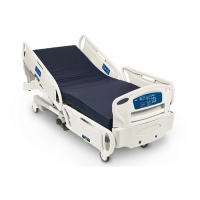
